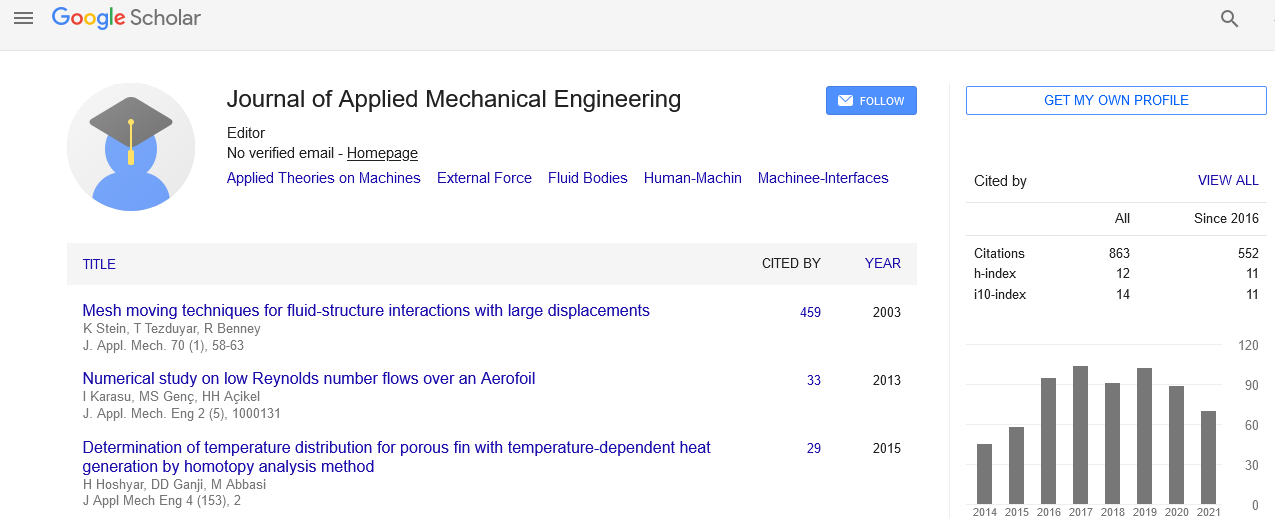Indexed In
- Genamics JournalSeek
- JournalTOCs
- CiteFactor
- RefSeek
- Hamdard University
- EBSCO A-Z
- OCLC- WorldCat
- Publons
- Google Scholar
Useful Links
Share This Page
Journal Flyer

Open Access Journals
- Agri and Aquaculture
- Biochemistry
- Bioinformatics & Systems Biology
- Business & Management
- Chemistry
- Clinical Sciences
- Engineering
- Food & Nutrition
- General Science
- Genetics & Molecular Biology
- Immunology & Microbiology
- Medical Sciences
- Neuroscience & Psychology
- Nursing & Health Care
- Pharmaceutical Sciences
Perspective - (2025) Volume 14, Issue 1
Hydraulics in Mechanical Engineering: Harnessing Fluid Power for Efficiency and Precision
Carsten Kuhn*Received: 14-Nov-2023, Manuscript No. JAME-23-23906; Editor assigned: 17-Nov-2023, Pre QC No. JAME-23-23906 (PQ); Reviewed: 01-Dec-2023, QC No. JAME-23-23906; Revised: 09-Jan-2025, Manuscript No. JAME-23-23906 (R); Published: 16-Jan-2025, DOI: 10.35248/2168-9873.25.14.524
Description
Hydraulics, the science of utilizing fluid properties to perform mechanical tasks, has long been a cornerstone of mechanical engineering. This field harnesses the power of liquids, typically oil, to transmit force and energy, enabling the design and construction of machinery that is efficient, powerful and precise. This article delves into the diverse applications of hydraulics in mechanical engineering, exploring the underlying principles, key components and the transformative impact it has on various industries.
Understanding hydraulics in mechanical engineering
Hydraulics operates on the principle that fluids, incompressible in nature, can transmit force uniformly in all directions. This fundamental concept forms the basis for the design and implementation of hydraulic systems in mechanical engineering. The key components of a hydraulic system include a hydraulic fluid, a pump to generate fluid flow, valves to control the flow and actuators that convert fluid pressure into mechanical motion.
The basic principle of hydraulics involves the use of Pascal's law, which states that any change in pressure applied to an enclosed fluid is transmitted undiminished to all portions of the fluid and to the walls of its container. In hydraulic systems, this principle is harnessed to create a transfer of force from one point to another through the medium of hydraulic fluid.
Applications in mechanical engineering
Heavy machinery and construction: Hydraulics play a pivotal role in heavy machinery used in construction and mining. Excavators, bulldozers and cranes utilize hydraulic systems for precise control of movement and heavy lifting. The ability to transmit high forces with accuracy makes hydraulics indispensable in these applications.
Aerospace engineering: Hydraulic systems are widely employed in aerospace applications, particularly in the operation of aircraft landing gear and control surfaces. The reliability and efficiency of hydraulic systems contribute to the safety and performance of aircraft during take-off, landing and in-flight maneuvers.
Automotive engineering: Hydraulic systems are integral to the automotive industry, with applications ranging from braking systems to power steering. Hydraulic brake systems provide reliable and responsive braking, while hydraulic power steering systems enhance driver control and comfort.
Manufacturing and automation: In manufacturing, hydraulics are utilized in various processes, including metal forming, injection moulding and material handling. Hydraulic presses, for instance, exert tremendous force for shaping metal components, contributing to the efficiency of manufacturing processes.
Renewable energy: Hydraulics also finds applications in renewable energy systems, such as hydroelectric power plants. Hydraulic turbines convert the kinetic energy of flowing water into mechanical energy, which is then transformed into electricity. The efficiency and scalability of hydraulic systems make them key components in sustainable energy generation.
Challenges and innovations
While hydraulics offer numerous advantages, there are challenges that engineers must address to optimize performance and sustainability. Hydraulic systems are susceptible to fluid leaks and contamination, which can compromise efficiency and lead to component wear. Ongoing research focuses on developing advanced seals and filtration systems to mitigate these issues and enhance the longevity of hydraulic systems. The environmental impact of hydraulic fluids, often based on petroleum, raises concerns. Efforts are underway to develop environmentally friendly hydraulic fluids, such as bio-based or synthetic alternatives, to minimize the ecological footprint of hydraulic systems. Improving the efficiency of hydraulic systems and minimizing energy consumption is an ongoing challenge. Innovations in pump and valve technology, as well as the integration of smart control systems, aim to enhance the overall efficiency of hydraulic systems, making them more sustainable and cost-effective. As technology advances, there is a growing demand for miniaturized and portable hydraulic systems. Developing compact components and systems without compromising performance is a key focus area, especially in industries where space constraints are critical.
Conclusion
Hydraulics, a fundamental aspect of mechanical engineering, continues to shape the design and functionality of a wide array of systems and machinery. From heavy construction equipment to aerospace technology and renewable energy systems, hydraulics provides the force and precision needed to accomplish complex tasks. As the field evolves, engineers are faced with the challenge of enhancing efficiency, reducing environmental impact and integrating hydraulic systems with emerging technologies. The future of hydraulics in mechanical engineering holds exciting possibilities, with innovations in smart systems, miniaturization and sustainability poised to further expand the reach and impact of hydraulic technology. In the dynamic landscape of mechanical engineering, hydraulics remains a driving force, enabling the efficient and precise movement of the world around us.
Citation: Kuhn C (2025) Hydraulics in Mechanical Engineering: Harnessing Fluid Power for Efficiency and Precision. J Appl Mech Eng. 14:524.
Copyright: © 2025 Kuhn C. This is an open-access article distributed under the terms of the Creative Commons Attribution License, which permits unrestricted use, distribution, and reproduction in any medium, provided the original author and source are credited.

